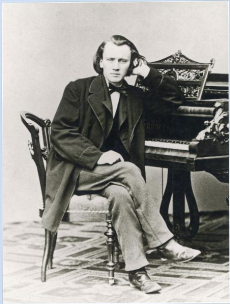
Johannes Brahms is a renowned German composer, who lived in the nineteenth century. Brahms is a very interesting composer in that he both favoured tradition, but was also incredibly innovative with his works. Many of his works were left unpublished or even destroyed, due to Brahms’ perfectionism. He employed many techniques from the Classical and Baroque period, such as counterpoint, devised by J.S. Bach, wherein two voices or instruments are related harmonically, but not rhythmically or in their contours. Brahms was interested in preserving the ‘purity’ of German structures of music, whilst also moving his works into a Romantic style. As such, Brahms is regarded as one of the greatest composers of all time.
Brahms’ Symphony no.2 in D major, op.73 is classed as a Romantic composition. It is a mostly ‘cheerful’ sounding piece, partially due to the choice of the key, but the adagio does create a sense of melancholy. The first movement is more faced paced, being an allegro. The primary focus of this movement is on the interaction between the woodwinds and the French horn. Harmonies are immediately evident, with the woodwinds playing a third higher than the horn in the allegro non troppo section. Brahms uses trombones as a method of ‘punctuation’ for the piece, having them play solemn chords at certain intervals. Violins are employed to mimic the conclusion of this movement, playing triadic figurations.
The following transitional section is composed of fragments from the original theme, and leads into two new motives on the violin and the oboe. The violin plays a scaleic passage before reaching a heightened and sustained note, then it steadily cascades. The oboe to an extent plays a contrasting passage, with a steadily ascension of chords. The juxtaposition creates an interesting textural dynamic for the piece, but yet, there is still a sense of fluidity.
The second theme begins with a violincello. It has been described as ‘Mendelssohnian’ in its ‘sentimentality.’ The section contains some repeating patterns of a minim leading into two tied quavers, before a descending of notes, the initial pattern repeated again, before a further descent.
Within this symphony, the final theme is perhaps the most noteworthy and has the most impact. The development section is quite concise, but again plays with the use of contrasting ideas to create impressive effect. However, the recapitulation is almost abrupt in its nature and arrival, but features many variations of theme, before leading into a coda for final emphasis. The French horn is now playing the leading melody, with woodwinds and violins accompanying, playing abbreviations of the most effective passages of the piece at alternating intervals, both emphasizing the other with their syncopation.
The second movement is an adagio, which begins with beautiful cello melodies. We can clearly see again Brahms’ favouring of harmonies and counterpoint. The first cello has an initial singular note, a third above the note played in the first short melody of the second cello. Brahms continues with using harmonies in fourths among others, creating a more interesting dynamic for the piece due to the more unusual though effective harmonies. The adagio is particularly sorrowful at points, and it seems like it is ‘seeking the key that will enable it to break out of a melancholy circle.’ There is a sense of resolve with a section in 12/8 with gentle rises and falls, directed as ‘dolce.’ However, a third section sees the return to the melancholy mood seen at the beginning of the theme; Brahms’ use of juxtaposing structure proves particularly effective, as the piece leaps into a ‘passionate climax.’
The third movement sees the return to the allegro, and equally, a more cheerful tone. Brahms opts for more simplistic harmonies and instrumentation. Here we see the central theme of the symphony being altered rhythmically, but also reinforced by secondary, complimentary themes. For example, the main theme is in a middle range, played as ‘piano,’ whereas the secondary theme is a much higher octave, instructed as ‘forte,’ which a quicker succession of notes.
The finale of Brahms’ symphony is another allegro, ‘high-spirited and overflowing with life.’ The primary theme has an edge of suspense, as it begins quietly, ‘piano,’ with a sweetly flowing melody, incorporating gentle rises and falls, reaching a gradual ascension, with all notes played as a smooth legato, before going into an equally fluid and gradual descent, with a couple of short, faster scaleic bars. After this, we see a complete transition into the loud and effective ‘forte,’ with a much more fragmented theme. Further subsidiary themes are included, softly played, lower pitched themes, reminiscent of the integral theme. Overall, it is a very impressive work that clearly demonstrates Brahms’ mastery of harmony, but also his sense of innovation, with his stark contrasts and contrasts between lushly orchestrated passages, and simple, stripped back, yet beautiful passages.
Image1: http://www.jonathanjamesmusic.com/the-jaws-open-brahms-symphony-1/

0 Comment:
Be the first one to comment on this article.